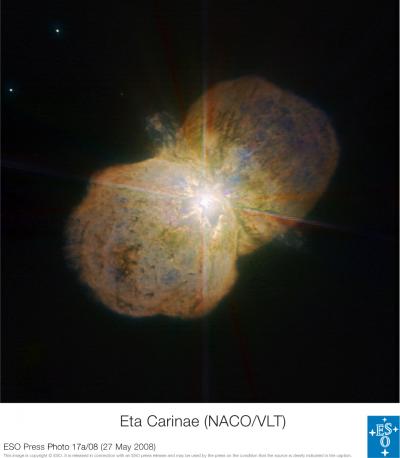Eta Carinae has the shape of a 'little man' and surrounds a star doomed to explode within the next 100 000 years.
Being brighter than one million Suns, Eta Carinae is the most luminous star known in the Galaxy. It is the closest example of a luminous blue variable, the last phase in the life of a very massive star before it explodes in a fiery supernova.
Eta Carinae is surrounded by an expanding bipolar cloud of dust and gas known as the Homunculus ('little man' in Latin), which astronomers believe was expelled from the star during a great outburst seen in 1843 [1].

Eta Carinae was one of the first objects to be imaged during First Light with ESO's VLT, 10 years ago. At the time, the image obtained with a test camera already showed the unique capabilities of the European flagship telescope for ground-based optical and infrared astronomy, as well as of its unique location on the mountain of Paranal. The image had a resolution of 0.38 arcseconds.
The new, recently obtained image reveals even more, with a resolution a factor of 6 to 7 times better. It was obtained with the NACO near-infrared instrument on Yepun, Unit Telescope 4 of the VLT. NACO is an adaptive optics instrument, which means that it can correct for the blurring effect of the atmosphere. And looking at the image, the power of adaptive optics is clear. The image quality is as though the whole 8.2-m telescope had been launched into space [2].
When viewed through the eyepiece of a small telescope, the Homunculus may indeed resemble a little man, but the astounding NACO image clearly shows a bipolar structure. Also very well resolved is the fine structure of the jets coming out from the central star.
Last year, the Very Large Telescope Interferometer also studied Eta Carinae in great detail and provided invaluable information about the stellar wind of Eta Carinae (see ESO 06/07).
The second image was obtained with the ISAAC infrared imager on Antu, Unit Telescope 1.
Located 9 000 light-years away, i.e. farther away than Eta Carinae, NGC 3576 is also in the direction of the southern Carina constellation. NGC 3576 is about 100 light-years across, that is, 25 times larger than the distance between the Sun and its closest neighbouring star.
This intriguing nebula is a gigantic region of glowing gas, where stars are currently forming. The intense radiation and winds from the massive stars are shredding the clouds from which they form, creating dramatic scenery. It is estimated that the nebula is about 1.5 million year old, the blink of an eye on cosmological timescales.
Astronomers from the University of Cologne [3], Germany, have studied this region with ESO's Very Large Telescope and ISAAC to determine the proportion of stars still having a protoplanetary disc from which planets form. Looking at young regions of different ages, the astronomers hope to estimate the lifetime of protoplanetary discs and thereby better understand how planets form. In particular, the scientists are interested in looking at the effect of the strong radiation of the stars, as well as of stellar encounters in these dense regions, on the survival of the discs.
Notes
[1]: In fact, since the distance to Eta Carinae is about 7500 light-years, the eruption must have taken place about 7700 years ago.
[2]: Given the large size of each Unit Telescope of the VLT, the resolution achievable when using adaptive optics (the 'diffraction limit') is as good in the longer near-infrared wavelengths, where NACO observes, as what the HST can achieve in the visible. The resolution is indeed close to 0.05 arcseconds, ten times better than what one can typically obtain without adaptive optics on an excellent site. A resolution of 0.05 arcseconds corresponds to being able to read a book 10 km away.
[3]: The astronomers are C. Olczak, R. Schödel, S. Pfalzner, and A. Eckart.


